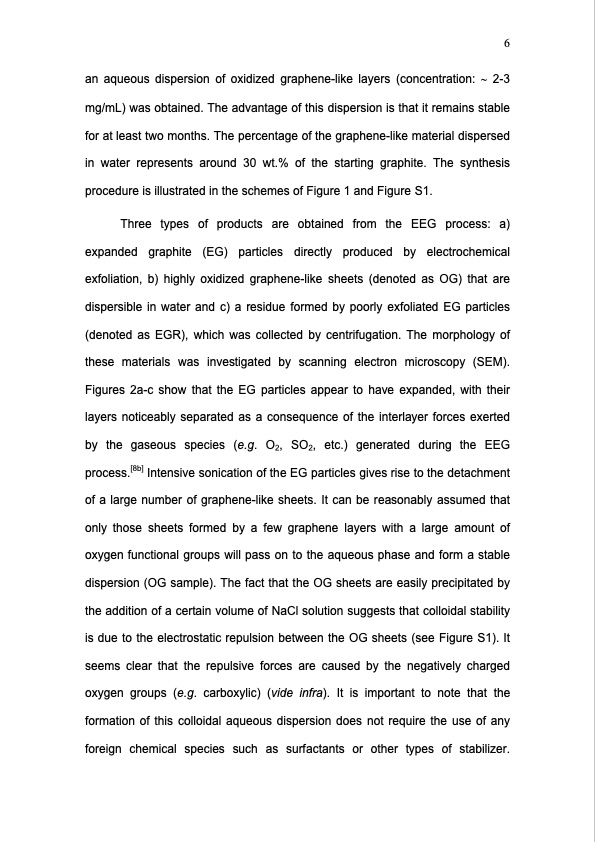PDF Publication Title:
Text from PDF Page: 006
an aqueous dispersion of oxidized graphene-like layers (concentration: ∼ 2-3 mg/mL) was obtained. The advantage of this dispersion is that it remains stable for at least two months. The percentage of the graphene-like material dispersed in water represents around 30 wt.% of the starting graphite. The synthesis procedure is illustrated in the schemes of Figure 1 and Figure S1. Three types of products are obtained from the EEG process: a) expanded graphite (EG) particles directly produced by electrochemical exfoliation, b) highly oxidized graphene-like sheets (denoted as OG) that are dispersible in water and c) a residue formed by poorly exfoliated EG particles (denoted as EGR), which was collected by centrifugation. The morphology of these materials was investigated by scanning electron microscopy (SEM). Figures 2a-c show that the EG particles appear to have expanded, with their layers noticeably separated as a consequence of the interlayer forces exerted by the gaseous species (e.g. O2, SO2, etc.) generated during the EEG process.[8b] Intensive sonication of the EG particles gives rise to the detachment of a large number of graphene-like sheets. It can be reasonably assumed that only those sheets formed by a few graphene layers with a large amount of oxygen functional groups will pass on to the aqueous phase and form a stable dispersion (OG sample). The fact that the OG sheets are easily precipitated by the addition of a certain volume of NaCl solution suggests that colloidal stability is due to the electrostatic repulsion between the OG sheets (see Figure S1). It seems clear that the repulsive forces are caused by the negatively charged oxygen groups (e.g. carboxylic) (vide infra). It is important to note that the formation of this colloidal aqueous dispersion does not require the use of any foreign chemical species such as surfactants or other types of stabilizer. 6PDF Image | Graphene from Electrochemically Exfoliated Graphite

PDF Search Title:
Graphene from Electrochemically Exfoliated GraphiteOriginal File Name Searched:
80863368.pdfDIY PDF Search: Google It | Yahoo | Bing
Salgenx Redox Flow Battery Technology: Power up your energy storage game with Salgenx Salt Water Battery. With its advanced technology, the flow battery provides reliable, scalable, and sustainable energy storage for utility-scale projects. Upgrade to a Salgenx flow battery today and take control of your energy future.
CONTACT TEL: 608-238-6001 Email: greg@infinityturbine.com (Standard Web Page)